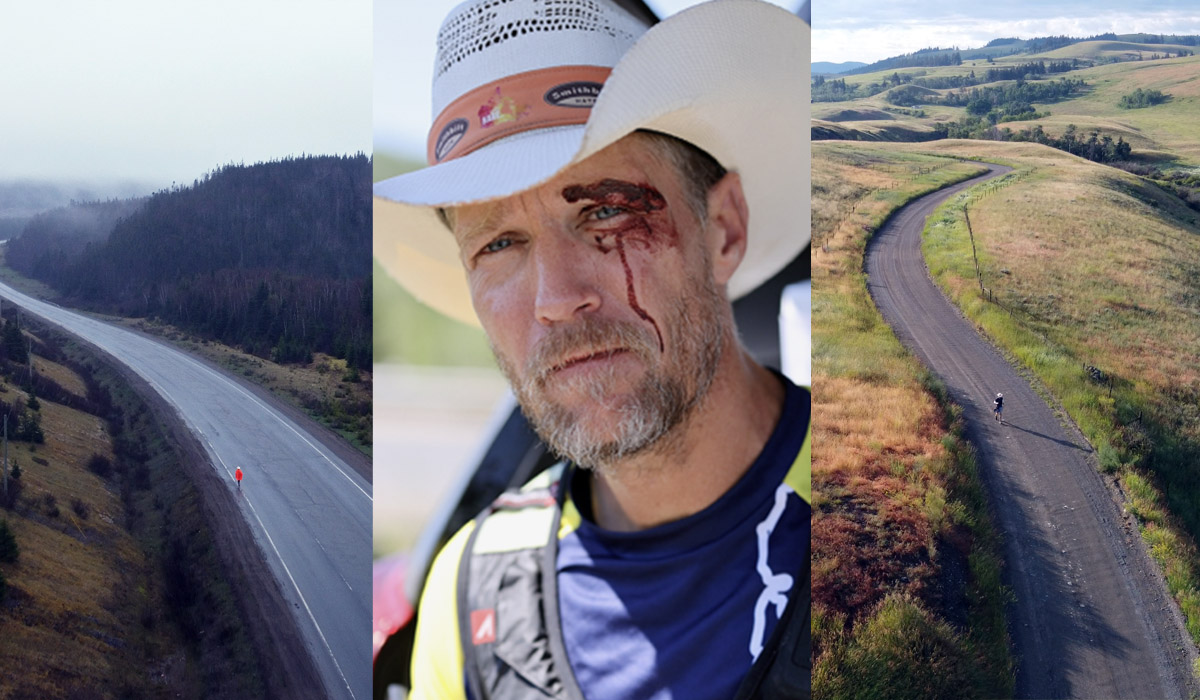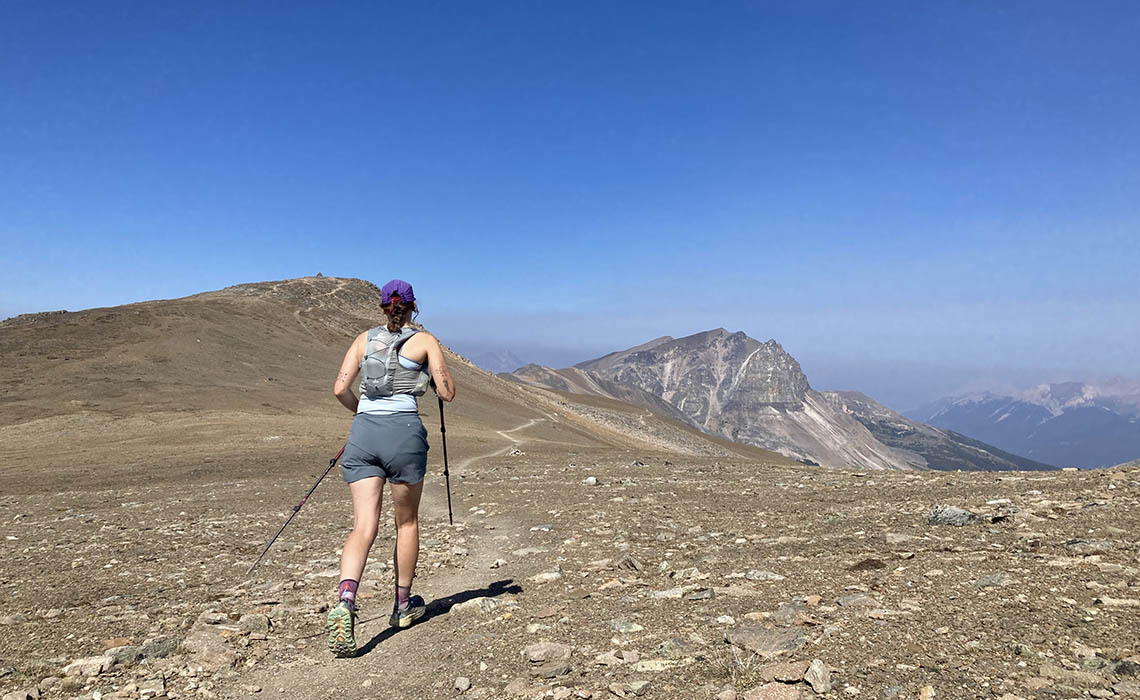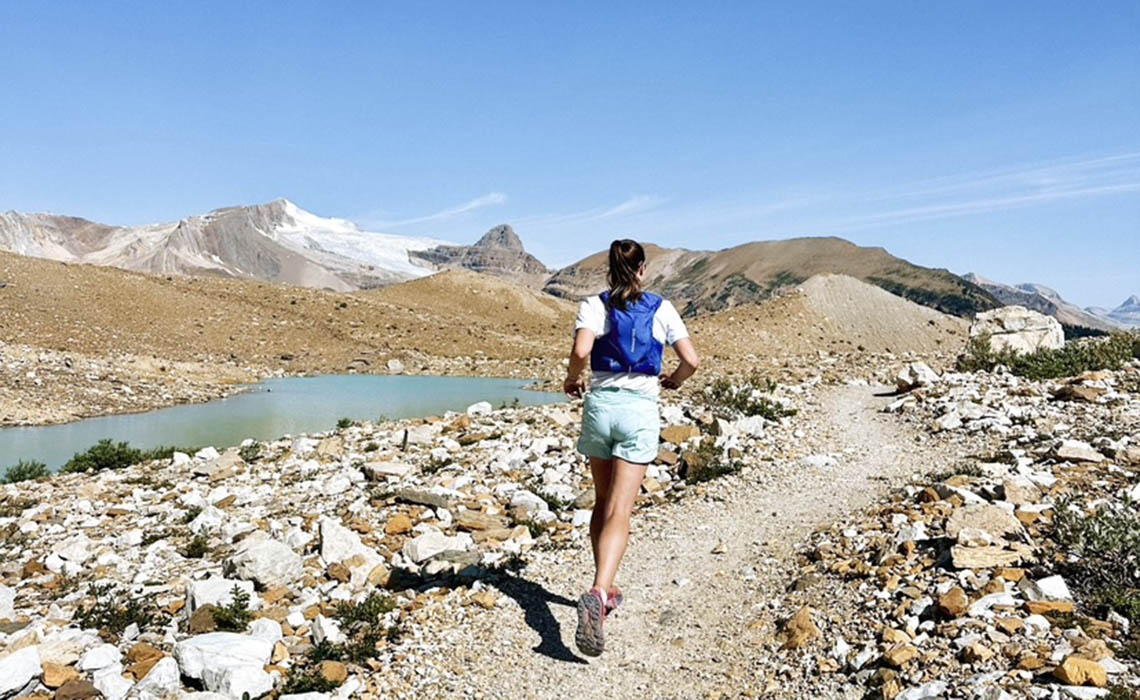Going the extra, extra mile

The sun sets behind the mountains and shrinks my world to the small beam of a headlamp. My feet are a minefield of hotspots and blisters, the undersides of my arms are chafed and raw. Going up another hill makes my calves scream. Every muscle screams, actually. And although I know I need to eat, my stomach threatens to violently revolt. Is the pain I’m feeling harmful or dangerous? Nope, onwards!
I am 14 hours into an ultramarathon race traversing the trails of Kalamalka Lake Provincial Park in Vernon, BC, and only slightly questioning my life decisions. Sweaty, sore and covered in dirt, I find myself smiling. This is absurd, and exactly what I signed up for. Well, almost. I could have done without the record-high 30-degree weather in mid-September. Mother Nature sure has a sick sense of humour … She must be an ultra runner, too.
Ultramarathon 101
Put simply, an ultramarathon is any footrace longer than the standard 42.2-km marathon. Distance-based races are the most popular, often taking place on trails and mountainous terrain. Jumping between measurement units, common distances include 50 km, 50 mi. (80.5 km), 100 km and 100 mi. (161 km). There are also multi-stage events where different routes are completed over consecutive days, or ultras where runners go as far as possible within a set time period, such as 12, 24 and 48 hours (flat roads and running tracks are more conducive to this style).
And then you have the unique (no, masochistic) backyard ultra, a format with no set time or distance. Racers complete a 6.7-km loop, known as a yard, every hour on the hour (equal to 100 mi. per day), until only one runner is left standing. If a runner completes a yard in 50 minutes, they have 10 minutes to refuel, change gear and possibly power nap before starting again. Slow, steady and sleep-deprived wins the race.
There’s really nothing glamorous about running really, really far. It requires weeks, months and sometimes years of training and monotonous miles. After you’ve put in all that work, race day throws in its own myriad of challenges. Fatigue, muscle cramps, blisters, chafing, gastrointestinal distress, sleep deprivation, acute injuries, adverse weather … The only real guarantee is your mettle will be tested.

And still, registration numbers are booming. In 2023, UltraRunning Magazine reported a 1,032 per cent increase in North American ultra participants since 2000, jumping to 86,333 runners from 8,362. In Alberta alone there were over 30 ultra-distance events last year, from the fast and flat Calgary Marathon 50 km to the grueling Divide 200 miler along portions of the Great Divide Trail in the Rockies.
For a sport unapologetically steeped in discomfort, why are so many people eager to toe the starting line?
Finding your why
Curiosity has always been constant in Dave Proctor’s ultra journey. Proctor is a registered massage therapist, author, speaker, Mount Royal alumnus and one of the most accomplished distance runners in the country. With an ultra career spanning 18 years, the thought, “Is this humanly possible?” has powered him from the lowest of lows to the highest of highs, from broken bones to broken records.
Reflecting on how it all began, Proctor says he once thought running 100 km and beyond couldn’t be possible. After watching runners complete the feat in real time, his skepticism was replaced with a desire to see where his own two feet could take him. “I wanted to find what came first, the bottom of the well or the end of the rope. I wanted to find my limit,” he says.
Sierra Hope, an MRU ecotourism and outdoor leadership program graduate, was introduced to ultra running at a young age by her grandparents. While she was happy to volunteer at races and cheer on her grandpa, she wasn’t interested in doing it herself. “I was always super against running. I was the kid who faked being sick to get out of running in gym class,” she laughs.
But the spirit of inquiry got the best of her after she moved to Canmore, AB, and made friends in the trail running community. “They opened my eyes to what was possible. I was surrounded by people who were pushing themselves and wanted to see what I was capable of,” she says, adding that trail running also became a way for her to explore more of the mountains in less time. Hope crushed her first 50-km ultra last fall.
There are almost two decades separating Proctor and Hope’s inaugural race experiences, but how they ended up at the starting line isn’t so different. That intrinsic shift from “there’s no way” to “let’s see if I can do it” is a prevalent theme in the ultra community. Labelling something as impossible puts up a barrier and limits beliefs. Dismantle that barrier and suddenly there’s room to reframe your potential. Start chasing that potential — now you’re in a place where the magic happens.
“There’s nothing quite like seeing people cross the finish line,” Proctor says. “They dug way deeper than society-at-large convinced them was reasonable to do and they earned it. And then they think, ‘If I can do that, what else in my life could I accomplish?’ It’s a reminder of how innately strong we truly are.”
Across the country, one step at a time
In Proctor’s perpetual search for his limit, he has set numerous course records, the Canadian 24-, 48- and 72-hour distance records, and a couple of Guinness World Records for good measure. In hindsight, these were all just a warm-up for what he describes as his personal Everest: breaking the trans-Canada speed record.
From the logistics and planning required to the sheer size of the country, everything about running across Canada is of behemoth proportions. Now just add in the small factor of doing it in record time. Always up for a challenge, Proctor made his first attempt in 2018. After 32 days of running from Victoria to Winnipeg, a ruptured disc in his back forced him to stop.
Four years later, he again laced up his shoes, donned his signature cowboy hat and set out for the record, this time starting in St. John’s, NL and running west. The coast-to-coast, 7,159-km odyssey threw every kind of hurdle his way: severe weather, catching Covid-19, a stress fracture, a concussion, close calls with distracted drivers and the overall mental and physical toll of running all day, every day.

“It’s a lot of time to locate exit doors on the highway, to catastrophize and make mountains out of molehills,” Proctor reflects. He was constantly faced with two options: quit running or embrace the discomfort and persist. And over and over again, step after step, he chose the latter.
After 67 days, 10 hours, 27 minutes, Proctor had officially run across Canada faster than anyone in history.
To put this feat in perspective, Proctor covered 7,159 km (averaging 14 hours and 105.2 km per day) with a total elevation gain of 47,584 m (equivalent to climbing Everest five times), consumed 7,000 to 9,000 calories per day, slept seven and a half hours each night, went through 12 pairs of running shoes and took zero rest days.
Confronting discomfort
In his memoir, Untethered: The Comeback Story of One of the Longest Fastest Runs in History, Proctor writes about how we are genetically programmed to prioritize comfort over effort.
“We typically accept some things as too difficult or too painful and give up, especially when survival is not on the line and we have plenty of food in the fridge.”
What happens if we mentally flip that switch? “We can endure many things.”
To Proctor’s point, ultramarathons provide a privileged space where runners can step into discomfort and see how it feels to stay there awhile. It’s a voluntary suffering that challenges one to adapt, endure and persevere in the face of adversity.
“We often look for excuses to pull the plug well in advance of where we should, but it’s okay to be uncomfortable and go, ‘I’m okay,’ Your body will produce when the mind lets it,” he says.
For those who do choose to embrace the discomfort, science suggests that the fortitude cultivated on the trails can remain well past the finish line. A study in the Australian Journal of Psychology found that when compared to non-athletes, ultramarathoners are more adaptive, resilient and have a lower response rate to negative stimuli.
Additional research published in Psychoneuroendocrinology suggests that “runner’s high” (the release of feel-good endorphins in the brain sometimes associated with physical activity) may act as a natural painkiller in response to discomfort. Way back, this could have aided in the survival of our ancestors by helping them persevere while chasing down food.
“The beautiful thing about ultramarathons is that it ties us back to a heritage of who we are as humans,” Proctor says. “We’re incredible survivalists, but we tend to forget that. We forget that we are as competent and capable and resilient as we truly are.”
Mind over miles
Whether trying to break a cross-country record or still training for a first race, there’s a universal truth all ultra runners must face: running alone for hours on end means ample opportunity to get stuck in your own head.
Proctor recalls competing in Big’s Backyard Ultra in 2021, the world championships of backyard racing. He was 40 hours deep with 13 other competitors still running.
“I remember thinking, ‘I could win this.’ But then I realized winning was realistically going to take 80 to 100 hours, so I’m going to have to run through the rest of tonight and all the next day and all the next night and all the next day … I got ahead of myself. And I dropped out within 15 minutes.”
While a tough lesson to learn, it was one that Proctor would take with him into his second trans-Canada attempt. In Untethered, he writes, “Ultimately, accepting that the current moment is all we ever have puts things into perspective. The past has been, and the future is yet to come. Our effort must be focused only on what we can do now.”
MRU psychology professor Dr. Carrie Scherzer, PhD, explains that mindfulness, the cognitive skill of staying present in the moment, can be a powerful tool when the mind starts to wander. What if I do (or don’t) meet my goals? What if I get too tired to finish the race? What if…
“Mindfulness silences the what ifs and keeps an athlete in their activity, in the moment. One foot after the other, one breath after another,” Scherzer says, adding that breathing techniques, imagery and self-talk can also help to push through the low points.
During Hope’s training, slowing down her pace, focusing on her surroundings and running with friends were her preferred way to stay in a positive mental space. “I had to overcome the desire to stop in almost every long run I’ve ever done,” she admits.
Learning to quiet that voice allowed her to make more space for the sheer enjoyment of moving through the mountains. “I find it kind of meditative to run for hours on the trails. It’s all about finding the rhythm that your body can keep up with and your mind is free.”
Damage control
Ultra running asks a lot of the physical body, but it doesn’t glorify pushing beyond the point of true injury. Even athletes who are seemingly superhuman know there is a line they shouldn’t cross when it comes to personal health, such as Proctor’s first trans-Canada attempt. But how does one know where that line is?
Dr. Jared Fletcher, PhD, an associate professor of exercise physiology and biomechanics at MRU, explains that there is a difference between an acute injury, such as spraining an ankle or twisting a knee, and the general muscle damage experienced while training or running a race.
“Technically, we would still consider the muscle damage an injury, but it’s one that accumulates during the activity and can be treated with rest and ice after the fact,” he says. In other words, it may cause discomfort in the moment, but it isn’t overly harmful in the long run. “Through proper training, you can start to differentiate between what is normal, what generally happens after 40, 50 or 60 kilometres, or if there is something seriously wrong.”

Mindset can also play a role in interpreting physical cues. “Mental training can help an athlete tolerate pain or discomfort by framing it,” Scherzer says. “For example, I know that my knee is hurting because of an accident in the past. I know that I can safely keep running on it because I completed rehab and strengthened that area.” She adds the caveat that if an injury is new, it’s probably best to have it evaluated before pushing through.
This is probably a good time to add that running as a whole is actually really good for your body. Benefits include preventing osteoarthritis, improving muscle strength and cardiovascular function, and reducing the risk of Alzheimer’s and dementia, Fletcher says.
'An eating and drinking race'
Running legend Ann Trason famously quipped that ultramarathons are “an eating and drinking race with a little bit of running.” Visit an aid station at any ultra and you’ll find everything from Coca-Cola, chips, candy and gels to fruit, chicken broth and grilled cheeses. In short, food is fuel and you need a whole lot of fuel to make it through an ultra. On top of that, simple carbohydrates, such as sugar, are easy to digest and convert into short-term energy.
Proctor’s trans-Canada record highlights this well. Needing to eat upwards of 8,000 calories a day, calorie- and carb-dense baked goods became a staple in his diet. So much so that he and his crew joked it was really just a long run from one roadside bakery to the next.
It’s not all fun and croissants, though. Gastrointestinal issues top the list of reasons a runner may drop from a race. Constantly moving while constantly fuelling can be a lot for a stomach to handle. There’s also the possibility of flavour or texture fatigue (if I even think about consuming another gel, I’m going to hurl). The solution? Working to train your gut just as you would your muscles and mind.
Practising proper fueling during training runs means less shock to your system during the race when getting in calories becomes crucial. It’s also a time to test what sits well with your system, whether that’s solid food, gels or liquids. In Proctor’s case, he taught his stomach to digest more efficiently through years of running on a full stomach, a training method he refers to as “gastric emptying.”
Proper training can also lead to helpful physiological changes in terms of where our body goes to find fuel. “When you train long, slow distances, your body naturally starts to adapt to using more fats for energy compared to carbohydrates,” Fletcher explains. At a very, very high level, the average human body has a storage capacity for about 1,500 calories of carbohydrates. Meanwhile, just one pound of fat holds 3,500 calories — even for the leanest of athletes, that’s an incredible source of energy to tap into.
In short, consistent eating and drinking helps put more logs on the fire while adaptations gained from the training cycle help the fire burn more efficiently, both contributing to a better race experience.
Progress over perfection
Running economy — how efficiently a runner uses energy, akin to the fuel economy of a car — is often a top metric for predicting performance. The rule of thumb being that a better running economy translates to a better race outcome. But as Fletcher explains, ultra running challenges this concept.
“The unique part about endurance running, especially in events spanning over 100 kilometers, is that ultra runners tend to sacrifice running economy. They purposefully do things that increase their energy costs.”
While this seems counterintuitive, Fletcher breaks it down as runners choosing the lesser of two evils. Carrying extra water and food in a running vest is an added physical burden, but dehydration and underfueling is a big risk that can easily lead to a DNF (did not finish). Using running poles in mountainous terrain may result in less efficient form, but taking some weight off the legs can reduce muscle damage and keep a runner moving stronger in the latter stages.

In fact, research suggests that race management during ultras, such as proper pacing, injury avoidance, nutrition management and mental fortitude, play a more significant role than traditional predictors of performance like running economy.
This isn’t to say that you can simply eat and adapt your way through an ultra, but rather that longer races introduce more variables to navigate, therefore requiring runners to diversify their strengths. A solid foundation of training is necessary, but something like an absolutely dialed running economy becomes less important as the distance grows.
And at the heart of it all lies one of the beautiful lessons of the ultra world: perfection is not a prerequisite for progress. Rather, it’s the willingness to embrace the unknown and adapt to challenges that keeps us moving forward.
The pursuit of potential
Like any sport or hobby, ultra running isn’t for everyone. It’s dirty and gritty on many levels, requiring an immense amount of time and effort with no guarantee of success. But for a small (and growing) group of curious adventurers, the sacrifice is worth it.
Proctor once thought that running 100 km was impossible. Now he’s done the impossible 68 times in a row while crossing the entirety of Canada on foot. Hope grew up doing everything in her power to avoid running, and now she’s eagerly signing up for more races to see just how far and fast she can go.
“My initial reaction was ‘those people are absolutely insane’ and I still kind of feel that way, but I understand the insanity now,” she says. “I truly never saw myself being a runner until all of a sudden one day I was one.”
Maybe it’s not so much a sport measured in distance, but in the tenacity of the human spirit, and somewhere under the dirt and sweat and discomfort there lies something worth chasing far greater than a finish line.
(Plus, getting to eat lots of snacks along the way is a nice bonus, too.)

